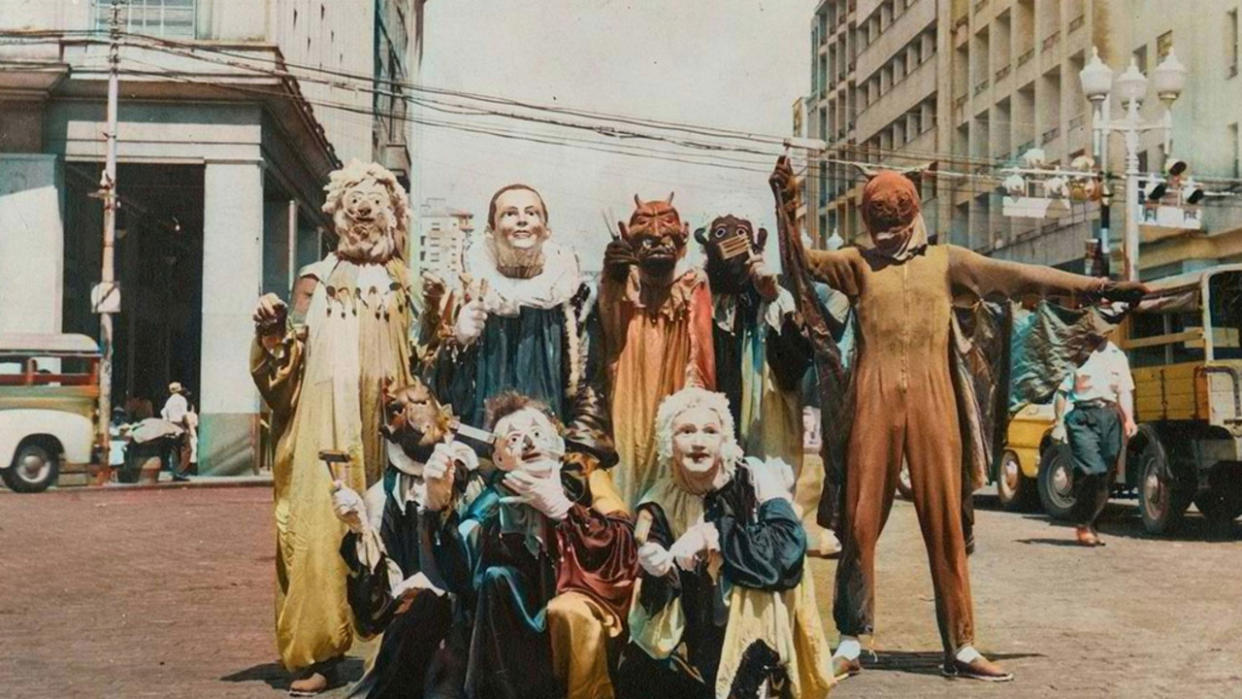‘Pictures of Ghosts’ Review: Kleber Mendonça Filho Immortalizes Brazilian Cinemas in Deeply Personal Work

- Oops!Something went wrong.Please try again later.

If you went to Cinema São Luiz today, instead of finding the most celebrated theater in Recife (the capital of Brazil’s state of Pernambuco), you would find closed doors and a now-iconic sign that reads, “We’ll see each other again soon.” Because of the pandemic and a seemingly endless renovation job on the government’s part, this hallowed ground has been sealed for all but three months since March 2020.
For locals such as myself, that’s partly why seeing it through the lens of Kleber Mendonça Filho’s incredibly personal new documentary “Pictures of Ghosts” feels so poignant. Through a mix of archival footage and new recordings, “Pictures of Ghosts” sees its director — whose filmography is already rich with deep, complex portraits of his hometown, such as “Neighboring Sounds” and “Aquarius” — revisiting the places that made him. Recife’s movie theaters are chief among them.
More from IndieWire
Once surrounded by screens of all sizes, the city’s cinephiles can no longer depend on multiplexes for getting their fix. By attempting to revive dead cinemas like Trianon, Art Palácio, and Moderno, “Pictures of Ghosts” smartly traces a line from the old days to now — identifying the death of movie palaces as a symptom of a larger disease. It’s a tragic notion the director furthers near the end of his film with a montage of drugstores, nodding to a local joke about Recife having one on every corner. Once upon a time, you could say the same about movie theaters.
But this nostalgic and melancholy trip is also a celebration. Scored with the energetic tunes of Tom Zé, Sidney Magal, and other Brazilian artists, “Pictures of Ghosts” is just as enamored with the streets and people surrounding those cinemas as it is with the rooms themselves. Effortlessly flowing through Recife’s 20th century, Filho’s direction gains a joyful rhythm, full of hope and wonder. Its title may recall images of the deceased, but it also brings to mind an enduring spirit — something ephemeral, but never fully gone. Though it has mutated and struggled, Filho’s Recife still stands tall.
In the first of its three acts, “Pictures of Ghosts” stays inside its director’s childhood apartment, almost as if before chronicling where art is shown, he must first show where it is made. From amateur movies to feature films, a lot of Filho’s work was shot in his home on the ever-changing South Side of Recife, a once suburban area now polluted by titanic skyscrapers. They are ideal stand-ins for the wave of redevelopment that has made Recife unrecognizable.
Filho’s relaxed voiceover guides us through his family’s history and lays the film’s ideas bare. “By combining ordinary sights and cinema’s lens, you get a movie,” he says, not so much narrating but rather engaged in casual conversation, revealing his approach to filmmaking. It was there that he grew up and found art, and where he claims to have photographed a ghost.
As Act Two transitions away from his apartment, Filho shows us more portraits of things that were once alive. But if the so-called phantom from his childhood home is presented in a tongue-in-cheek way, the ruins of Recife’s local cinemas are explored (in some cases, literally) with the utmost respect and sincerity. Whereas the tightness of its initial location provides a neat appetizer, perfectly condensing Filho’s essayistic style and offering amusing anecdotes from the filmmaker’s life, “Pictures of Ghosts” truly hits its stride when it steps out the door and strolls down memory lane in Old Recife: a neighborhood that stands as the city’s heart.
Described as a place powered by “screw-you” energy, this is where the documentary channels its themes of nostalgia, memory, and gentrification into fascinating juxtapositions — contrasting the glory days of the past with the emptiness of the here and now. Filho smartly identifies whatever ellipsis separates those points in time as spaces where drama and longing are found.
Aiding Filho in painting his back-and-forth time-traveling are newspaper articles, restored footage, and a handful of stories, often funny and often heartbreaking. What is a city if not a collection of its citizens’s fables? One such tale involving an old projectionist friend of Filho tickles us with the humorous distaste he acquired for “The Godfather” after playing the film for over four months, just before leading us to tears as he realizes he will be the one closing Art Palácio for good after finishing his next shift. That same theater provides “Pictures of Ghosts” one of its most fascinating and shocking tidbits; it was built by the Nazi-controlled UFA, but thankfully, its goal of spreading Hitler’s propaganda was never achieved.
Nearly all of Recife’s cinemas were once one thing before transforming into another, a realization that turns dire when, through Filho’s precise staging and Matheus Farias’s suspenseful editing, we visit them in their current state. A haunting sequence shows the abandoned halls of a building that housed one such cinema, where a few locals still live and work. We hear their footsteps and watch doors close as we go up and down its floors, but no one is ever seen. Instead, spirits are all around us.
Another theater was left behind in the midst of a crude and misguided plan to shape it into a shopping center, and Filho finds in its bizarre unfinished architecture a post-apocalyptic world. There is an odd power in these images. We can feel it when the digital remastering of a marquee with 1989’s “Batman” distorts the video, the glitch manifesting itself through weird pops that make the pixels appear to be awake and breathing. “Pictures of Ghosts” occasionally borrows the language of a horror flick to add some eerie touches. If the movie’s thesis seems to argue that images can bring memories back to life, moments like these suggest that what comes out of the grave may no longer be how we left it.
Be it time or decisions from those in power, there is an uncontrollable and unpredictable force at work. Just as people age, so do cities, and “Pictures of Ghosts” posits that the arthouses of a bygone era, forgotten if not for efforts like these, are often sacrificed at the altar of progress.
Fittingly, during the film’s final chapter, Filho points out how many of these places have been retrofitted into churches. A few are entirely desolate. One has turned into a department store, and its projection room now stores boxes of juice. But because of the benches and stage structures inherent to movie theaters, a different kind of temple has taken root in plenty of former cinemas. They are mostly occupied by the Assembly of God, Brazil’s most prominent evangelical denomination and a common choice among many in the lower class. Filho’s view on the matter is certainly not positive, but he does seem intrigued by this parallel.
In a later scene inside São Luiz, he brings up a popular saying about how, in Recife, one can only watch a new feature from Martin Scorsese or Glauber Rocha kneeling in reverence. Praise and prayer are still happening, even if the object of worship has changed. He never quite makes the thematic connection between the arts and religion that he’s going for, either trusting his audiences to bridge these worlds for themselves or unsure of what to say beyond bringing up this curious fact. But Filho does manage to establish what amounts to an optimistic reading of Recife’s situation: There is still something in these walls.
Months after premiering the documentary at Cannes, Filho was among the crowd that gathered in front of Cinema São Luiz one Sunday afternoon demanding answers from authorities. When will São Luiz reopen? When will we see each other again? There’s no date yet. Right after announcing the film, the director tweeted his intention to hold the first public showing in Brazil on that totemic screen.
That didn’t happen, but, in a way, “Pictures of Ghosts” has still immortalized the city’s greatest cinemas. The buildings may one day rot, but everyone in Recife can now point to this urgent, moving piece of preservation and find in it an eternal record of its film history.
Grade: A-
“Pictures of Ghosts” screened at the 2023 Toronto International Film Festival. It will be released by Grasshopper Films in the U.S. in early 2024.
Best of IndieWire
Sign up for Indiewire's Newsletter. For the latest news, follow us on Facebook, Twitter, and Instagram.

